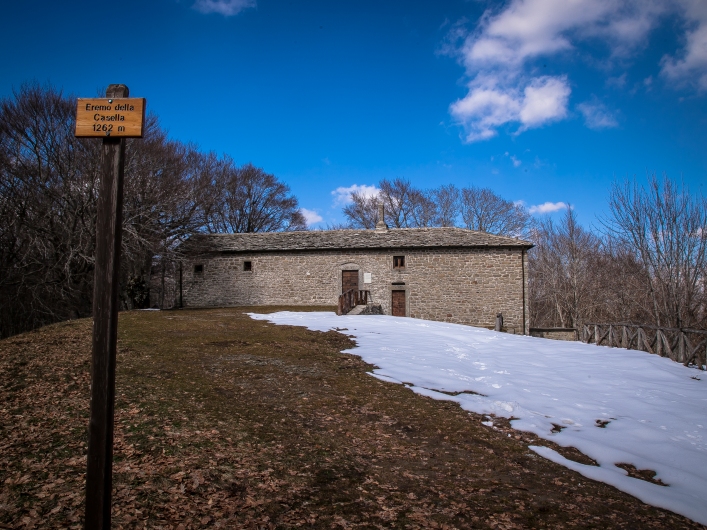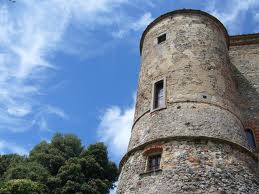Sanctuary of La Verna
Donated to Francesco by Count Orlando Cattani in 1213, the Monte Sacro della Verna is considered one of the most important places of Franciscan devotion.
The Saint from Assisi loved to retire in prayer and meditation in this distant place, protected by the foliage of the trees and hidden from all in the numerous ravines and caves that rise on the slopes of the rocky limestone spur of Monte Penna (1218 masl). In September 1224, during a night of solitary prayer, Francis received the stigmata, or the wounds of the Crucified Christ. This miraculous event and subsequent sanctification gave way to the construction of several churches and a monastery in place of the small chapel and cells used by Francis and his brothers. Today the Sanctuary of La Verna hosts a large community of friars and can accommodate hundreds of pilgrims.
Hermitage of Cerbaiolo

Clinging to a limestone spur of the Apennine ridge, the hermitage of Cerbaiolo has always been considered a small version of the nearby sanctuary of La Verna, so much so that the inhabitants of these lands have created a nice way of saying that reads: "Those who have seen the Verna and not Cerbaiolo, have seen the mother but not the son ”.
Truth be told, this hermitage was built well before the famous Franciscan sanctuary and it even seems that in this place there had already been a small monastery founded by the lord of Tiferno (Città di Castello) in the eighth century. The monastery was soon placed under the control of the Benedictine Order, passing to the Franciscan Friars only in 1306. Among the characters who retired in prayer in Cerbaiolo, in addition to St. Francis, there is St. Anthony of Padua and Sister Chiara, who died in 1210 and was the guardian of the hermitage for more than 40 years.
Hermitage of the Casella

Tradition has it that St. Francis, after receiving the Stigmata, left La Verna to reach Assisi on 30 September 1224. The itinerary he had to follow wound up towards Monte Foresto and reached the locality, on the top of the mountain, called the Casella.
From that height St. Francis, facing La Verna said: "Goodbye, mount of God! Goodbye Mount Auvergne! Remain in peace, we will not see each other anymore." The first historical trace of the Hermitage bears the date of 30 September 1228, the anniversary day of the Saint's departure. The population of the nearby parishes, although the place is more than an hour's walk from the towns, has always considered La Casella as a real Franciscan sanctuary. The annual recurrence for which we meet in the large lawn of the Hermitage is the day of the feast of Saints Peter and Paul.
Montauto Castle

The Montauto castle, together with Villa La Barbolana and the Galbino Castle, is one of the residences of the ancient Galbino family . In this place Francis, after receiving the Stigmata at La Verna in 1224, stopped for a few days. Here Alberto da Montauto gave him a new habit and received the old suit in exchange. The relic remained in the castle chapel until 1502 when the Florentines brought it to their city. The Montauto habit is the one currently exhibited at the Sanctuary of La Verna.
Hermitage of Montecasale

The Hermitage of San Francesco in Montecasale, a sacred building, located 700 meters high, built in the homonymous locality, within the municipal area of Sansepolcro. Tradition tells of an original foundation by the hand of St. Francis, in the year 1213. The Hermitage is a representative place of Franciscan spirituality, not only for having been the home of the Saint of Assisi, but also for having witnessed numerous miracles, such as that of the "conversion of the three thieves", operated by Francis himself.
Between the thirteenth and fourteenth centuries, a Marian cult developed around the image of the Madonna Enthroned with Child (13th century polychrome wooden sculpture) still visible inside the church. At the beginning of 1500, the Capuchin Friars Minor settled in the Hermitage and still live there today . The complex preserves the original layout of the most ancient Franciscan convents , which is characterized by the combination of small buildings functional to monastic life, around a central cloister, supported by large architrave stone pillars. A clear example of poor architecture, made with materials from the place, inspired by the simplicity of the life of the religious and in particular by the life of the Franciscans.








 Home
Home